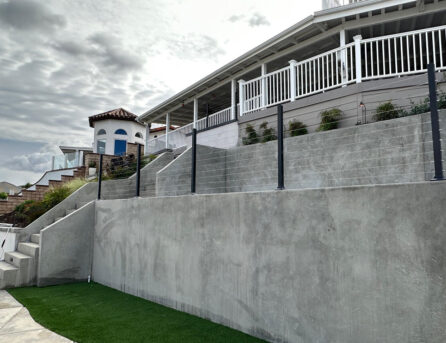
Retaining walls serve more than just functional purposes; they can significantly enhance the aesthetics, usability, and overall value of your property. Whether you’re looking to improve your landscape design or solve a practical issue like soil erosion, installing retaining walls offers several benefits that can increase your property’s worth.
Enhance Curb Appeal
One of the most immediate benefits of adding a retaining wall is its potential to enhance curb appeal. Retaining walls create depth and texture, turning an otherwise bland yard into a visually interesting space. With various materials available, such as stone, brick, or concrete, retaining walls can be customized to complement the architectural style of your home, adding a polished and sophisticated look. This boost in curb appeal not only makes your home more attractive but can also increase its market value.
Prevent Soil Erosion
If your property is on a slope, soil erosion can be a serious issue. Retaining walls help control this by holding back soil, preventing it from washing away during heavy rains. This is particularly important for properties where erosion could damage landscaping, cause flooding, or even affect the foundation of your home. By installing a retaining wall, you not only protect your property but also maintain the health and appearance of your landscape, which adds to your home’s value.
Create Usable Space
Sloped properties can be challenging to fully utilize. Retaining walls can transform an unusable hill into a series of terraced, flat areas perfect for gardens, patios, or outdoor living spaces. This added functionality can be a major selling point for prospective buyers who appreciate having more usable outdoor space. By maximizing your yard’s potential, you increase both the aesthetic appeal and practical value of your property.
Provide Structural Support
In addition to aesthetic and functional benefits, retaining walls offer critical structural support. They are designed to hold back soil and prevent landslides or shifts, making them essential for homes built on uneven terrain. The stability provided by retaining walls not only protects your home but can also enhance its long-term value by ensuring the integrity of your property.
Boost Property Value
By improving curb appeal, preventing erosion, creating functional spaces, and providing structural support, retaining walls are a valuable investment. Whether you plan to sell your home or simply want to enhance its features, retaining walls are a smart choice for increasing property value.
If you’re considering adding a retaining wall to your property, contact our concrete contractors in Temecula. We can offer you a consultation and explore the options that best suit your needs!
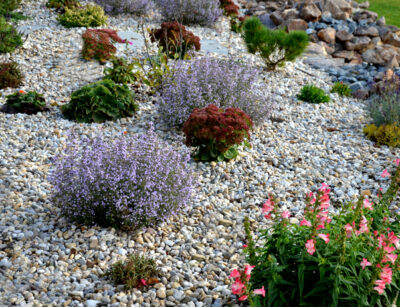
We’re accustomed to frequent droughts here in Southern California, but maintaining a lush, beautiful yard can be challenging. However, with the right selection of plants, you can create stunning, drought-tolerant landscaping that thrives even in dry conditions.
Consider incorporating these drought-tolerant plants into your garden. They will add beauty to your yard and, as a bonus, make your landscape much more sustainable!
1. Sedum (Stonecrop)
Sedums are succulent perennials known for their thick, water-storing leaves and vibrant flowers. They come in various shapes and sizes, making them versatile for ground cover, borders, or rock gardens. Sedums require minimal watering and thrive in well-drained soil.
2. Lavender
Lavender is a fragrant, flowering herb that thrives in dry, sunny locations. It’s perfect for borders and garden beds, attracting pollinators like bees and butterflies. Once established, lavender requires well-drained soil and minimal watering.
3. Agave
Agave plants are striking succulents with rosettes of thick, fleshy leaves. They are highly drought-tolerant and require very little maintenance. Agaves prefer full sun and well-drained soil, making them ideal for xeriscaping.
4. Yarrow
Yarrow is a hardy perennial with feathery foliage and clusters of tiny, colorful flowers. It’s drought-tolerant and can thrive in poor soil conditions. Yarrow is also beneficial for attracting beneficial insects to your garden.
5. Russian Sage
Russian Sage is a woody perennial with silvery-gray leaves and tall spikes of lavender-blue flowers. It’s extremely drought-tolerant and can thrive in poor, dry soils. This plant adds a beautiful, airy texture to garden borders.
6. Ornamental Grasses
Ornamental grasses like Blue Fescue, Fountain Grass, and Mexican Feather Grass are excellent for adding texture and movement to your garden. These grasses are drought-tolerant and require minimal maintenance, thriving in a variety of soil conditions.
7. Sage (Salvia)
Salvia species, such as Autumn Sage and Meadow Sage, are drought-tolerant perennials with vibrant flowers that attract pollinators. They thrive in full sun and well-drained soil, adding long-lasting color to your garden.
8. Blanket Flower (Gaillardia)
Blanket Flowers are hardy perennials known for their bright, daisy-like blooms. They are drought-tolerant and thrive in poor, sandy soils. These flowers add a burst of color to garden borders and attract pollinators.
Benefits and Care Tips for Drought-Tolerant Plants
Drought-tolerant plants offer several benefits, including reduced water usage, lower maintenance, and enhanced garden sustainability. To care for these plants, follow these tips:
- Soil Preparation: Ensure your soil is well-drained. To improve drainage, amend heavy clay soils with sand or organic matter.
- Mulching: Apply a layer of mulch around your plants to retain moisture and regulate soil temperature.
- Watering: Water deeply but infrequently to encourage deep root growth. Once established, many drought-tolerant plants require minimal watering.
- Pruning: Regularly prune dead or damaged growth to promote healthy new growth and maintain plant shape.
As experienced landscape designers in Temecula, CA, we can design a yard for you that is as resilient as it is beautiful. Enjoy the vibrant colors, textures, and benefits these plants bring to your outdoor space, and save money on your water bill at the same time! Contact us today for more information.

Our sunny, clear weather in Southern California brings us a lot of joy. But unfortunately, our gardens don’t always appreciate it as much as we do. Drought-tolerant landscaping, also known as xeriscaping, is becoming an increasingly popular choice for homeowners looking to create beautiful, sustainable outdoor spaces. This landscaping approach focuses on using plants and design techniques that require minimal water, offering numerous advantages.
Water Conservation
One of the most significant benefits of drought-tolerant landscaping is its ability to conserve water. Traditional lawns and gardens can consume large amounts of water, particularly in dry climates. By choosing drought-tolerant plants and implementing water-efficient irrigation systems, homeowners can significantly reduce their water usage. This not only helps preserve a precious natural resource but also supports local water conservation efforts.
Reduced Maintenance
Drought-tolerant landscapes require much less maintenance compared to traditional lawns and gardens. These plants are adapted to thrive in dry conditions, meaning they need less frequent watering, fertilizing, and pruning. Homeowners can enjoy a beautiful, thriving garden without the constant upkeep, allowing more time to relax and enjoy their outdoor spaces.
Cost Savings
By reducing water usage and maintenance requirements, drought-tolerant landscaping can lead to substantial cost savings. Lower water bills are one immediate benefit, as drought-tolerant plants require far less irrigation. Additionally, less frequent use of lawn care equipment and fewer purchases of fertilizers and pesticides can further reduce expenses. Over time, these savings can add up, making drought-tolerant landscaping a financially savvy choice.
Increased Property Value
A well-designed, drought-tolerant landscape can enhance the curb appeal of a home, potentially increasing its property value. Prospective buyers often appreciate the aesthetic and practical benefits of xeriscaping, including its low maintenance and sustainability. Homes with attractive, water-efficient landscaping can stand out in the real estate market, attracting environmentally conscious buyers and potentially commanding higher prices.
Environmental Benefits
Drought-tolerant landscaping also offers several environmental benefits. These plants are often native to the region, supporting local ecosystems and wildlife. Additionally, xeriscaping can reduce soil erosion and decrease the risk of water runoff, which can carry pollutants into local waterways. By choosing drought-tolerant landscaping, homeowners can contribute to a healthier environment.
Resilience to Climate Change
As climate change continues to impact our weather patterns, droughts are becoming more frequent and severe. Drought-tolerant landscapes are better equipped to handle these conditions, maintaining their beauty and functionality even during extended dry periods. This resilience ensures that homeowners can enjoy a thriving outdoor space regardless of changing climate conditions.
McCabe’s Landscape has an experienced design team that specializes in drought-tolerant landscaping. We’ll help you create beautiful, sustainable landscapes that support the environment and stand the test of time. Plus, you’ll save considerable time and water on garden maintenance! If you’re looking to make a positive impact on your finances and the planet, and lower your water bill at the same time, contact us today.
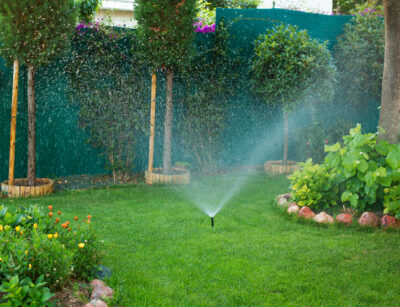
Maintaining a healthy lawn in Temecula during the hot summer months requires careful attention to your watering routine. Proper watering not only keeps your grass lush and green but also complements your swimming pool, creating a beautiful backyard space. Here’s how often and how much you should water your lawn during the summer.
Understanding Temecula’s Climate
Our Mediterranean climate means hot, dry summers with little rainfall. This climate necessitates a strategic approach to lawn care and watering to ensure your grass stays hydrated without wasting water.
Frequency of Watering
During the summer, your lawn needs frequent watering to combat the intense heat and dry conditions. Aim to water your lawn daily. This frequency helps maintain consistent soil moisture, allowing the grass to develop deep, healthy roots.
Timing of Watering
Watering your lawn at the right time of day is crucial for its health. The best time to water is early in the morning, between 4 a.m. and 10 a.m. Watering in the early morning minimizes evaporation, allowing the water to penetrate deep into the soil where it’s needed most. Avoid watering in the evening as this can lead to prolonged moisture on the grass blades, promoting fungal growth and disease.
Amount of Watering
When it comes to how much water your lawn needs, aim for about 1 to 1.5 inches of water per week. This amount should be divided across your three watering sessions. To determine how long to run your sprinklers, place a few empty tuna cans or rain gauges around your yard and measure the water collected after each session. Adjust your watering duration until you consistently achieve the desired amount.
Creating a Beautiful Backyard
A well-watered, verdant lawn is the perfect complement to your swimming pool, enhancing the overall aesthetics of your backyard. In addition to expert landscaping services, our Pool Contractors in Temecula design and maintain beautifully soothing backyard spaces that include both lush lawns and beautifully crafted pools.
For more information on how to keep your lawn green and healthy during the summer months, call McCabe’s Landscape Construction. Our team of experts is ready to provide you with personalized lawn care service and advice to create the perfect, harmonious outdoor living space.
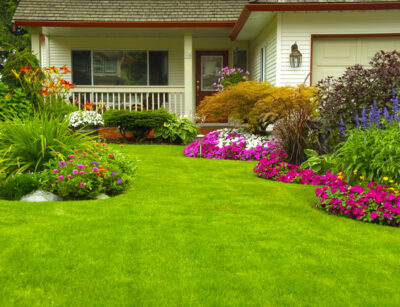
Maintaining a lush, green lawn in Temecula can be a rewarding endeavor, especially when it complements a beautiful swimming pool, creating a perfect backyard oasis. Fertilizing your lawn properly is essential to achieving that vibrant look. Here’s a guide on how often and when to fertilize your lawn in Temecula.
Understanding Temecula’s Climate
Temecula enjoys a Mediterranean climate with hot, dry summers and mild, wet winters. This climate necessitates a tailored approach to lawn care. Fertilizing your lawn at the right times ensures that it gets the nutrients it needs to thrive in each season.
Spring: Kickstart Growth
Spring is a critical time for lawn care in Temecula. As temperatures begin to rise, your grass will start to grow more actively. Applying a balanced fertilizer in early spring (March or April) helps kickstart this growth. Look for a fertilizer with a balanced ratio of nitrogen, phosphorus, and potassium to support healthy root development and green growth.
Summer: Sustaining the Lush Green
During the hot summer months, your lawn will need a little extra care to maintain its lush appearance. Apply a slow-release fertilizer in late spring or early summer (May or June) to sustain your lawn through the heat. This helps your grass stay strong and resilient, preventing it from becoming stressed and turning brown.
Fall: Preparing for Dormancy
In the fall (September or October), it’s time to prepare your lawn for the cooler months ahead. Fertilizing in the fall strengthens your grass’s root system, helping it survive the winter and come back strong in the spring. Choose a fertilizer with a higher potassium content to boost root development and disease resistance.
Winter: Minimal Maintenance
Temecula’s mild winters mean your lawn won’t go completely dormant, but its growth will slow down. Generally, additional fertilization isn’t necessary during the winter months. However, maintaining good watering practices and keeping your lawn free of debris will help it stay healthy.
Enhancing Your Backyard Oasis
A well-fertilized lawn enhances the beauty of your swimming pool, making your backyard an inviting retreat. Our Pool Contractors in Temecula create stunning outdoor spaces that combine lush green lawns with beautifully designed pools. Our expert team ensures that your lawn complements your pool perfectly, creating an appealing space for recreation and rejuvenation.
For more information on lawn care in Temecula, call McCabe’s Landscape Construction today. Our specialists are here to help you achieve the lush, green lawn that will perfectly accentuate your outdoor living space.
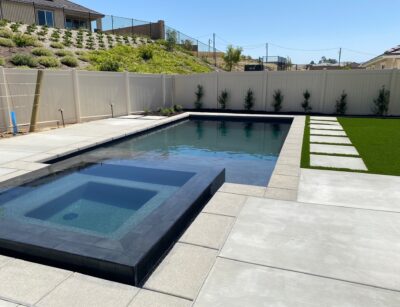
Transforming your backyard into a luxurious oasis has never been easier, thanks to innovative pool features that blend functionality with aesthetic appeal. For area homeowners looking to enhance their outdoor living spaces, pool contractors in Temecula offer a myriad of modern options, such as waterfalls, advanced lighting, and automation systems.
Waterfalls and Fountains
Waterfalls and fountains add a touch of elegance and serenity to any pool. The soothing sound of flowing water creates a peaceful ambiance, perfect for relaxation. Waterfalls can be integrated into the pool’s design with natural rock formations or sleek, modern materials, providing a stunning visual centerpiece. Fountains can be positioned around the pool or used as a central feature to add a dynamic element that transforms the overall look and feel of your backyard.
Advanced Lighting
Pool lighting has evolved significantly in recent years, offering much more than basic illumination. Modern LED lighting systems provide customizable options to set the mood for any occasion. From vibrant colors to soft, ambient hues, advanced lighting can enhance the aesthetic appeal of your pool area. Strategically placed underwater lights, pathway lights, and accent lights highlight your pool’s features and ensure safety during nighttime swimming. And for the busy homeowner, many lighting systems are now controlled via smartphone apps, allowing you to adjust settings with ease.
Automation Systems
Pool automation systems revolutionize the way we manage our backyard pools. These systems enable you to control various aspects of your pool environment with just a few taps on your smartphone or tablet. Whether it’s adjusting the water temperature, setting the filtration schedule, or turning on the pool lights, efficient automation systems make pool maintenance a breeze. Some advanced systems even offer features like chemical monitoring and automatic cleaning, ensuring your pool remains pristine with minimal effort.
Call us for Expert Advice
Incorporating these innovative features into your pool design not only enhances your backyard’s beauty but also adds functionality and convenience. Additionally, incorporating landscaping in Temecula can create a cohesive outdoor space that complements your new pool features. Are you ready to enjoy a luxurious, resort-like atmosphere right in your own backyard? Contact us today to start planning your backyard transformation.
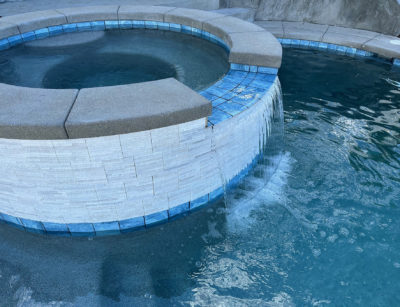
Choosing the right type of pool for your Temecula home can be a significant decision, impacting both your enjoyment and maintenance costs. Pool contractors in Temecula offer two popular options: saltwater and chlorine pools, each with its own set of advantages and drawbacks. Here’s a comparison to help you decide which is best for your needs.
Saltwater Pools
Pros:
- Gentler on Skin and Eyes: Saltwater pools have lower chlorine levels, making them less harsh on the skin and eyes compared to traditional chlorine pools.
- Lower Maintenance Costs: Once installed, saltwater pools tend to have lower chemical costs. The saltwater generator converts salt to chlorine, reducing the need to purchase and handle chlorine tablets or liquid.
- Softer Water Feel: Many people find that saltwater pools offer a more pleasant swimming experience, with softer-feeling water that doesn’t leave a strong chlorine smell.
Cons:
- Higher Initial Costs: Saltwater pools typically require a higher upfront investment due to the cost of the saltwater generator and the necessary installation.
- Potential for Corrosion: Saltwater can be corrosive to pool equipment and surrounding areas. It’s important to use corrosion-resistant materials and regularly inspect your pool components.
- Complex Maintenance: While day-to-day maintenance might be easier, saltwater pools require more sophisticated equipment and occasional maintenance of the salt cell, which can be complicated and costly.
Chlorine Pools
Pros:
- Lower Initial Costs: Chlorine pools are generally cheaper to install initially, making them an attractive option for budget-conscious homeowners.
- Effective Sanitation: Chlorine is highly effective at killing bacteria and keeping the pool water safe and clean.
- Simplicity: The maintenance routine for chlorine pools is straightforward. It involves regular chlorine additions and periodic shock treatments to manage algae and bacteria.
Cons:
- Harsh Chemicals: Chlorine can be irritating to the skin and eyes and may leave swimmers with a strong chemical smell.
- Ongoing Costs: Regularly purchasing chlorine can become expensive over time, and handling the chemicals requires care.
- Maintenance Frequency: Chlorine pools require frequent testing and chemical balancing to maintain water quality, which can be time-consuming.
For homeowners, the choice between a saltwater and chlorine pool ultimately depends on your priorities. If you prefer a gentler, low-maintenance swimming experience and are willing to invest more upfront, a saltwater pool might be the best option. However, if you’re looking for a lower initial cost and straightforward maintenance, a chlorine pool could be the way to go.
Consider your budget, maintenance preferences, and long-term costs to make the best decision for your family’s enjoyment and your home’s value. For more information on pool construction in Temecula or landscaping in Temecula, call us at McCabe’s Landscape Construction. We are your local and experienced pool contractors in Temecula and the surrounding areas.
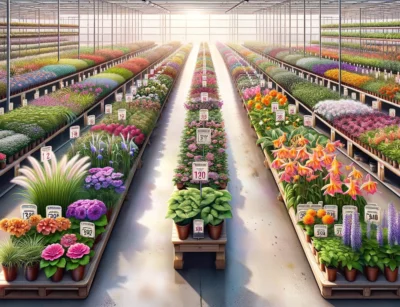
When it comes to selecting plants for your landscape, you may encounter a variety of options, including brand-named plants and more generic varieties. But what sets them apart, and what do they offer? Let’s explore the differences:
Quality and Consistency: Brand-named plants are often cultivated by reputable nurseries that adhere to strict quality standards and breeding programs. These plants are carefully selected for their superior traits, such as disease resistance, flower color, and growth habit. As a result, brand-named plants are known for their consistency in performance and reliability, making them a popular choice among gardeners and landscapers alike.
On the other hand, generic plants, while more affordable, may vary in quality and performance. Without the assurance of a trusted brand behind them, generic plants may exhibit inconsistencies in growth, flowering, and overall health. While some generic plants may perform well, others may fall short of expectations, leading to disappointment and frustration for gardeners.
Unique Varieties and Innovations: Brand-named plant breeders are constantly striving to introduce new and innovative varieties to the market. Through years of research and breeding efforts, they develop plants with unique features, such as novel flower colors, compact growth habits, and improved disease resistance. These exclusive varieties offer gardeners an opportunity to add something special and distinctive to their landscapes, setting them apart from the crowd.
While generic plants may offer a wide selection of common varieties, they may lack the novelty and innovation found in brand-named varieties. Gardeners seeking something unique and cutting-edge may find that brand-named plants better meet their needs and preferences.
Cost Considerations: One of the primary differences between brand-named plants and generic varieties is cost. Brand-named plants often come with a higher price tag due to royalties and additional costs associated with their long and expensive breeding process. These plants are patented and come with the assurance of quality, but this premium can add up, especially for larger landscaping projects.
Availability and Replacements: Another factor to consider is the availability of premium patented plants. While these plants may be highly sought after, they can be harder to find if you need replacements for the originals. Additionally, you can’t propagate more of these plants through division or cuttings without potentially violating plant propagation laws, making it more challenging to maintain a consistent look in your garden over time.
At McCabe’s Landscape Construction, we understand the importance of selecting the right plants for your landscape. Whether you prefer brand-named varieties or more generic options, our experienced team can help you make informed choices that align with your vision and budget. Contact us today to learn more about our plant selection and landscaping services. Let’s create a garden that’s perfect for you!
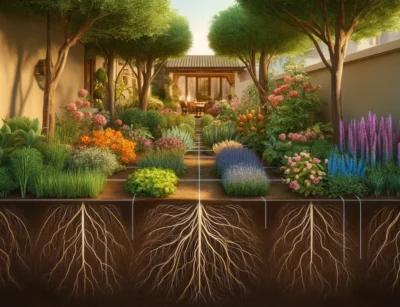
When it comes to planting new greenery in your landscape, giving your plants the space they need to flourish is key to their long-term health and vitality. Here’s why providing proper space for plant growth is essential:
- Healthy Root Development: Adequate spacing between plants allows room for root systems to expand and develop properly. When plants are crowded together, their roots compete for water, nutrients, and space, leading to stunted growth and increased susceptibility to disease. By giving each plant sufficient space to spread its roots, you promote strong and healthy root development, ensuring better nutrient uptake and overall plant vigor.
- Preventing Overcrowding: Overcrowded plants not only struggle to thrive but also create a breeding ground for pests and diseases. Proper spacing allows for adequate air circulation and sunlight penetration, reducing the risk of fungal infections, mold growth, and insect infestations. By maintaining proper plant spacing, you create a more resilient and balanced ecosystem in your landscape, where plants can coexist harmoniously without competing for resources.
- Aesthetic Appeal: Strategic plant spacing is not just about promoting plant health—it’s also about enhancing the beauty of your landscape. By carefully planning the placement of your plants and giving them room to grow, you create a visually pleasing arrangement that showcases each plant’s unique form, color, and texture. Whether you’re creating a lush garden bed or a minimalist modern landscape, proper spacing ensures that your plants have the space they need to shine and make a lasting impression.
At McCabe’s Landscape Construction, we understand the importance of proper plant spacing in creating thriving and beautiful landscapes. Our experienced team specializes in designing and installing landscapes that maximize plant health and aesthetic appeal. Contact us today to learn more about how we can help you create a landscape that’s as healthy as it is stunning.
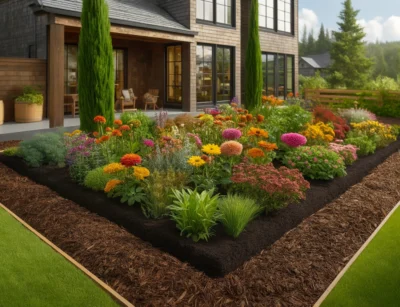
In the world of landscape construction, compost and mulch are like hidden gems, offering a multitude of benefits that go beyond mere aesthetics. Let’s explore why incorporating compost and mulch into your landscape design is a game-changer:
- Nutrient-Rich Soil: Compost is nature’s fertilizer, packed with essential nutrients that nourish plants and promote healthy growth. By enriching your soil with compost, you create a fertile environment where plants can thrive without the need for synthetic chemicals. This natural approach not only benefits your plants but also promotes soil health and biodiversity.
- Moisture Retention: Mulch acts as a protective blanket for your soil, helping to retain moisture and regulate temperature. By covering the soil surface with a layer of mulch, you reduce water evaporation, minimize soil erosion, and create a more stable microclimate for your plants. This moisture-retaining quality is especially beneficial in arid climates or during periods of drought, helping to conserve water and keep your landscape lush and vibrant.
- Weed Suppression: Say goodbye to pesky weeds with the help of mulch! By forming a barrier over the soil, mulch inhibits weed growth by blocking sunlight and preventing weed seeds from germinating. This natural weed suppression method reduces the need for chemical herbicides and manual weed removal, saving you time and effort in maintaining your landscape. Plus, as mulch breaks down over time, it adds organic matter to the soil, further enhancing its fertility and health.
At McCabe’s Landscape Construction, we believe in harnessing the power of nature to create sustainable and beautiful landscapes. Our team is dedicated to incorporating compost and mulch into our designs to maximize the benefits for our clients and the environment. Contact us today to learn more about how we can elevate your landscape with our eco-friendly practices and expert craftsmanship.
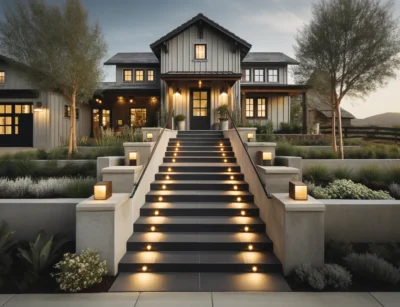
In landscape construction, every detail counts, particularly when it comes to the spacing of steps. It’s not just about making your garden look good—it’s about making it safe and accessible for everyone, while adhering to both state and local building codes. Here’s why getting step spacing right should be a top priority:
Adherence to Building Codes: In California, state-wide and local building codes specify the acceptable heights and variability for steps. These regulations are designed to ensure safety and uniformity in all types of construction, including residential landscapes. By following these guidelines, we not only comply with legal requirements but also enhance the safety and functionality of your outdoor spaces.
Safety First: Ensuring consistent step spacing isn’t just about compliance; it’s essential for preventing trips and falls. Uneven steps can be a tripping hazard, posing a particular risk to kids, the elderly, and anyone with mobility issues. Keeping step height and width uniform helps everyone move more safely through your outdoor areas.
Improved Accessibility: When steps are evenly spaced and conform to building codes, it’s easier for people of all abilities to enjoy your space. Consistent steps mean a smoother transition between different levels of your garden or patio, which is essential for inclusivity.
Enhanced Aesthetic Appeal: Uniform steps don’t just keep people safe; they also please the eye. Regular spacing contributes to a sense of order and symmetry, which can transform the look of your outdoor space, whether you’re going for a sleek modern look or a cozy, rustic vibe.
To make your residential steps even safer and more appealing, consider these additional tips:
1. Add a Handrail: Incorporating a handrail can significantly increase safety, providing stability for those who need it.
2. Decorative Concrete Finishes: Use different textures or colors in your concrete to visually indicate the change in level. Not only does this enhance safety, but it also adds a touch of style to your steps.
3. Strategic Lighting: Install step lights or path lights to illuminate the way at night. This not only prevents accidents but also adds a charming ambiance to your outdoor space.
At McCabe’s Landscape Construction, we pride ourselves on our meticulous attention to detail and our commitment to both beauty and functionality. Contact us today to find out how we can help you create a space that is as safe as it is stunning. Let’s build something beautiful—and safe—together!
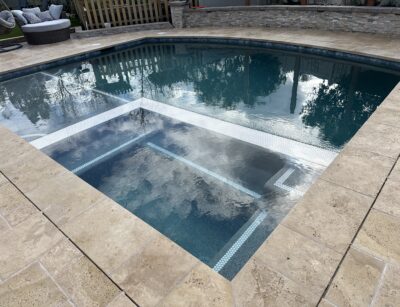
Entering a spa is like stepping into a realm of relaxation and rejuvenation, but ensuring your experience is safe and enjoyable requires a bit of know-how. Whether you’re soaking solo or bringing along the family, here’s how to make the most of your spa time while staying safe and comfortable.
Mind the Temp
Temperature is key when it comes to spa safety. Before dipping a toe in, check that the water temperature falls within the recommended range of 100°F to 104°F (37°C to 40°C). Anything hotter can pose risks such as overheating or dehydration. If you’re unsure, it’s always better to err on the side of caution and opt for a cooler soak.
Don’t Linger Too Long
As tempting as it may be to linger in the soothing waters indefinitely, it’s essential to limit your time in the spa. Experts advise staying in for no longer than 15 to 20 minutes at a time to prevent overheating and dehydration. After your soak, take a break to cool down before considering another dip.
Keep Kids Safe
When it comes to spa safety for kids and teens, supervision is paramount. Children under five years old should avoid hot tubs altogether due to their sensitivity to high temperatures. Older kids and teens can enjoy a soak, but under close supervision to ensure they don’t stay in too long or engage in rough play that could lead to accidents.
It’s also important to educate children and teens about spa safety rules, such as no diving or running around the spa area. Remind them to stay hydrated by drinking plenty of water and to listen to their bodies—if they start feeling dizzy or lightheaded, it’s time to get out and cool down.
Consider Health Conditions
Lastly, always be mindful of your own health and comfort while enjoying the spa. If you have a medical condition or are pregnant, consult with your healthcare provider before soaking. Listen to your body’s cues and exit the spa if you start feeling unwell.
By following these simple guidelines, you can ensure a safe and serene spa experience for yourself and your loved ones. So go ahead, sink into the warm waters, and let your worries melt away, knowing you’re taking care of your well-being every step of the way. If you have questions about installing a spa or landscaping your backyard oasis, call us and we’ll be happy to help!
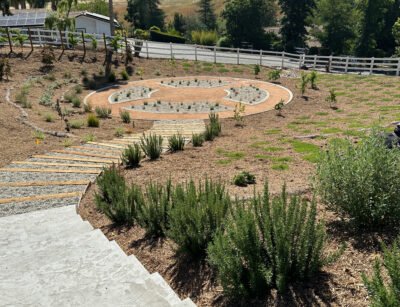
In an age where environmental consciousness is paramount, eco-friendly landscaping offers a harmonious blend of sustainability and beauty. Gone are the days of high-maintenance lawns and chemical-laden pesticides; instead, homeowners are embracing practices that not only enhance the natural beauty of their outdoor spaces but also promote biodiversity and conservation.
At the heart of eco-friendly landscaping lies the principle of working in harmony with nature rather than against it. This means selecting native plants that are adapted to the local climate and soil conditions, reducing water consumption, and minimizing the use of chemical fertilizers and pesticides.
Native plants play a pivotal role in eco-friendly landscaping. Not only do they require less water and maintenance than exotic species, but they also provide essential habitat and food sources for local wildlife. By incorporating a diverse array of native plants into your landscape design, you can create a vibrant ecosystem that supports pollinators, birds, and other beneficial organisms.
In addition to native plants, sustainable landscaping practices also emphasize water conservation. This can be achieved through techniques such as xeriscaping, which involves using drought-tolerant plants and minimizing turf grass areas, as well as installing rain gardens and rainwater harvesting systems to capture and reuse water runoff.
Eco-friendly landscaping also seeks to minimize the use of chemical inputs that can harm the environment and human health. Instead of relying on synthetic fertilizers and pesticides, consider natural alternatives like compost, mulch, and beneficial insects to nourish your plants and control pests organically.
Another key aspect of eco-friendly landscaping is promoting soil health. Healthy soil is the foundation of a thriving landscape, providing essential nutrients and supporting plant growth. By practicing techniques such as composting, mulching, and avoiding soil compaction, you can foster a rich and fertile soil ecosystem that sustains plant life for generations to come.
Eco-friendly landscaping offers a holistic approach to outdoor design that prioritizes sustainability, biodiversity, and environmental stewardship. Follow the principles outlined here, and you can create a beautiful and resilient landscape that not only enhances the beauty of your home but also contributes to a healthier planet for future generations to enjoy. Call us if you have any questions! We can help you design and implement a landscape that meets your aesthetic values while supporting your “green” goals.

In the hustle and bustle of modern life, finding moments of tranquility can feel like a luxury. Yet, amidst the chaos, our outdoor spaces hold the potential to become sanctuaries of peace and rejuvenation. Welcome to the world of landscaping for wellness, where the design of your outdoor environment can nourish not only your body but also your mind and spirit.
Imagine stepping into your backyard and feeling an immediate sense of calm wash over you. This is the power of intentional landscaping for wellness. By carefully selecting plants, materials, and layout, you can create a space that promotes relaxation, mindfulness, and overall well-being.
One of the key principles of landscaping for wellness is creating harmony with nature. Incorporating native plants into your landscape not only supports local biodiversity but also reduces maintenance requirements and water consumption. Native plants are adapted to the local climate and soil conditions, making them resilient and low-maintenance additions to your outdoor space.
In addition to native plants, consider incorporating elements that engage the senses. Fragrant flowers, like lavender or jasmine, can infuse the air with soothing aromas, while the sound of a trickling water feature can drown out the noise of the outside world and promote a sense of tranquility. Incorporating textures, such as smooth stones or rough bark, can further stimulate the senses and create a multi-sensory experience.
Another aspect of landscaping for wellness is creating spaces for relaxation and reflection. Whether it’s a cozy seating area tucked away in a quiet corner or a secluded garden nook surrounded by lush foliage, having designated spaces for rest and contemplation can encourage mindfulness and stress reduction.
Furthermore, don’t underestimate the power of color in influencing mood and emotion. Cool tones, like blues and greens, can evoke feelings of calm and serenity, while warm hues, like yellows and oranges, can promote energy and vitality. By carefully selecting plants and accessories with color in mind, you can create a landscape that supports your desired emotional state.
Landscaping for wellness is about more than just creating a visually appealing outdoor space—it’s about designing an environment that nourishes the mind, body, and spirit. Give us a call, and we’ll help you cultivate a sanctuary of well-being right in your own backyard.

Have you ever found yourself staring at your garden after a heavy downpour, only to find it overrun with weeds seemingly overnight? Don’t fret; you’re not alone. Heavy rain can create the perfect breeding ground for weeds, turning your meticulously tended garden into a jungle seemingly in the blink of an eye. But with a few strategies up your sleeve, you can navigate this weedy landscape like a seasoned gardener.
Use the Right Tools
First things first, arm yourself with the right tools. A sturdy pair of gloves and a reliable weeding tool are your best allies in the battle against weeds. With these in hand, you’re ready to tackle even the most stubborn invaders.
Be Proactive
Next, adopt a proactive approach. Don’t wait for the weeds to take over; instead, stay vigilant and nip them in the bud (literally) as soon as they appear. After a heavy rain, weeds can sprout up quickly, so regular maintenance is key to keeping them at bay.
Technique Matters
When it comes to removing weeds, technique matters. Rather than just pulling from the surface, aim to remove the entire root system to prevent regrowth. For deep-rooted weeds, like dandelions or thistles, a tool with a long, narrow tip can help you get to the root of the problem—literally.
But what about those hard-to-reach places, like between paving stones or along fence lines? For these tricky spots, consider using a weed killer. Opt for a non-toxic, environmentally friendly option to minimize harm to surrounding plants and wildlife.
An Ounce of Prevention
Prevention is always better than cure, so take steps to discourage weed growth in the first place. Mulching your garden beds can help smother weeds and retain moisture, while regular watering can promote the healthy growth of your desired plants, giving them a competitive edge over weeds.
Practice Patience
Finally, embrace the power of patience. Rome wasn’t built in a day, and neither is a weed-free garden. Keep up with your maintenance routine, and over time, you’ll reap the rewards of your hard work with a lush, thriving garden that’s free from the tyranny of weeds.
While heavy rain can certainly bring its share of challenges, with the right tools, techniques, and mindset, you can navigate the weedy aftermath like a pro. So roll up your sleeves, grab your gloves, and get ready to reclaim your garden from the clutches of unwanted invaders. Happy gardening!
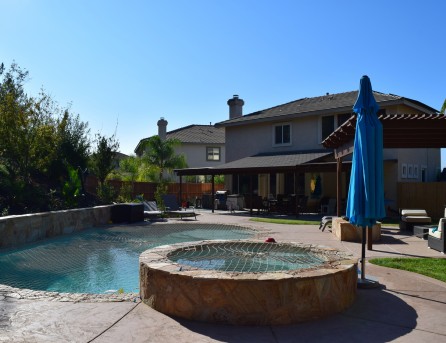
When it comes to pool maintenance, one essential accessory stands out: the pool cover. Not only do pool covers help keep your pool clean and clear, but they also play a crucial role in energy conservation and safety.
Types of Pool Covers
Pool covers come in various forms, each offering unique benefits to suit different preferences and needs. Traditional options include solid covers, which provide robust protection against debris and UV rays, and mesh covers, designed to allow water to pass through while keeping leaves and debris out. Additionally, solar covers harness the power of the sun to heat your pool water while minimizing evaporation and chemical loss.
Options for Automation
For those seeking convenience and efficiency, automated pool covers are an excellent investment. These covers can be operated with the push of a button, effortlessly gliding open or closed, saving time and effort. Automated covers not only enhance convenience but also bolster safety by providing a barrier that prevents unauthorized access to the pool area.
Safety Considerations
Safety implications are a crucial consideration when selecting a pool cover. Solid covers and automated covers offer excellent safety features, effectively preventing accidental falls into the pool and minimizing the risk of drowning, especially for households with children or pets. Mesh covers, while effective at keeping debris out, may not provide the same level of protection against accidental submersion.
Efficiency Matters
To keep pool energy costs down and maintain water clarity, homeowners can implement several strategies. Utilizing a solar cover helps retain heat, reducing the need for heating systems and lowering energy consumption. Regularly cleaning the pool cover and skimming debris from the water’s surface minimizes strain on filtration systems, improving efficiency and water clarity. Additionally, investing in energy-efficient pool equipment, such as variable-speed pumps and LED lighting, further reduces energy consumption and operating costs over time.
Pool covers are indispensable accessories that contribute to cleanliness, safety, and energy efficiency. Whether opting for traditional covers or embracing automation, prioritizing safety features and implementing energy-saving practices ensures a clean, clear, and cost-effective pool environment for years to come. If you need more guidance with regard to swimming pool design and maintenance, we can help. Call us to discuss your ideas, and we’ll help you select the right options for you.
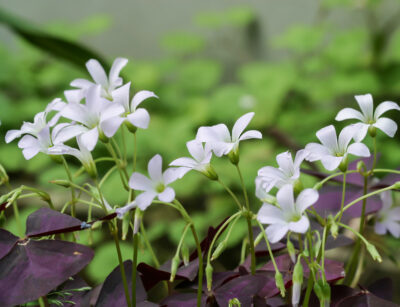
Are you looking to add a touch of luck and charm to your home or garden? Look no further than shamrocks, also known as Oxalis. These delightful plants not only bring a vibrant burst of greenery but also symbolize good fortune and prosperity. Whether you’re a seasoned gardener or just starting out, here’s everything you need to know about growing your own shamrocks.
Shamrocks are relatively easy to grow, making them perfect for both indoor and outdoor settings. If you opt for indoor cultivation, choose a bright, sunny spot near a window where your shamrocks can bask in plenty of indirect sunlight. Outdoor growth is also possible, especially in regions with mild climates, where shamrocks can thrive in partial shade or filtered sunlight.
When it comes to planting, ensure your shamrocks are in well-draining soil to prevent waterlogging, which can cause root rot. You can either start with bulbs or propagate from existing plants by dividing their rhizomes. Plant the bulbs or rhizomes just below the soil surface, spacing them out to allow room for growth.
One of the charming aspects of shamrocks is their ability to return each year, especially when grown in suitable conditions. Indoors, with proper care and maintenance, shamrocks can continue to flourish for several years, bringing joy and luck to your living space. Outdoors, in mild climates, shamrocks can even naturalize and spread, forming lush carpets of green foliage. You can enjoy a touch of Irish charm in your garden year after year!
To ensure the longevity of your shamrocks, provide them with consistent moisture, allowing the soil to dry out slightly between waterings. Fertilize your plants sparingly during their active growing season to encourage healthy growth and vibrant foliage. Additionally, remove any spent blooms or yellowing foliage to promote continuous flowering and maintain the plant’s aesthetic appeal.
Growing your own shamrocks is a rewarding endeavor that adds a touch of Irish charm and luck to your surroundings. Whether cultivated indoors or outdoors, these resilient plants are sure to delight with their cheerful blooms and enduring presence year after year. So, roll up your sleeves, embrace your green thumb, and let the magic of shamrocks flourish in your home or garden. And, as always, give us a call if you have any questions about your landscaping projects. We’ll be happy to help with advice, planning, or anything else you need!
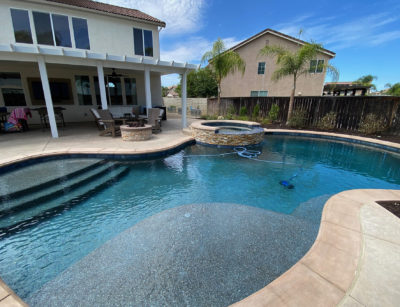
Embarking on a pool construction project in Riverside County brings excitement and anticipation, but it also entails ensuring your project meets stringent safety standards. A crucial step in this process is the pre-plaster inspection, where adherence to safety protocols is paramount. Let’s delve into the essential safety measures to prepare for this inspection, ensuring a smooth and compliant pool construction process.
Door Alarms
First and foremost, installing door alarms on all access points leading to the pool area is imperative. These alarms serve as a crucial safety feature, alerting homeowners when doors leading to the pool are opened unexpectedly, reducing the risk of unauthorized access, especially for young children or pets. Additionally, integrating safety devices such as pool covers or fences with self-latching gates adds an extra layer of protection, preventing accidental falls into the pool area.
Fences and Gates
When it comes to fences and gates, Riverside County regulations stipulate specific requirements to ensure the safety of pool areas. Fences should typically be at least 60 inches in height, constructed from durable materials such as wrought iron or mesh, and feature self-closing and self-latching mechanisms on all gates. Compliance with these standards not only enhances safety but also ensures a seamless pre-plaster inspection process.
Pool Alarms
Water alarms emerge as another crucial safety component in Riverside County pool regulations. These alarms are designed to detect disturbances in the water, such as when a child or pet falls into the pool, emitting a loud sound to alert nearby individuals. Water alarms act as a vital early warning system, allowing for swift intervention in emergencies and potentially saving lives.
Fun and Safety for Years to Come
Each safety measure plays a pivotal role in safeguarding individuals and minimizing potential risks associated with pool construction. By prioritizing safety at every stage of the process, new pool owners can get through the process smoothly and then enjoy a secure and enjoyable pool environment for years to come. Call us if you have any questions about swimming pool construction, and we’ll help you design your dream backyard escape.
Maintaining a pristine pool isn’t just about the shimmering water; it’s about the filtration system keeping it that way. When it comes to pool filtration, two popular options stand out: saltwater and chlorine. Each has its own set of benefits and drawbacks, enticing pool owners to weigh their options carefully.
Saltwater Filtration
Saltwater filtration systems have gained popularity for their perceived gentleness on the skin and eyes. The allure of a saltwater pool lies in its lower chlorine levels, which can be less harsh on swimmers’ skin and hair. Additionally, saltwater systems are often lauded for their lower maintenance requirements and reduced chemical costs over time. The soft, silky feel of the water is an added bonus, creating a more enjoyable swimming experience for many.
However, saltwater systems come with their own set of considerations. While they may have lower chlorine levels, they still require chlorine generation through the electrolysis of salt, which can corrode certain pool materials over time if not properly monitored. The initial installation costs of saltwater systems are also higher than traditional chlorine systems, making them a pricier investment upfront. Moreover, saltwater systems can be more complex to maintain and troubleshoot, requiring specialized knowledge and equipment.
Chlorine Filtration
On the other hand, chlorine remains a stalwart choice for pool owners seeking reliability and affordability. Chlorine effectively kills bacteria and algae, ensuring a safe and sanitary swimming environment. Its straightforward application and availability make it a convenient option for many. Additionally, chlorine systems typically have lower initial costs compared to saltwater systems, making them more accessible to a wider range of pool owners.
However, the strong odor and potential irritation to skin and eyes associated with chlorine can be off-putting to some swimmers. Furthermore, the regular addition of chlorine chemicals and balancing pH levels can become tedious and costly over time.
Making the Decision
The decision between saltwater and chlorine filtration systems ultimately boils down to personal preferences, budget, and maintenance capabilities. While saltwater systems offer a gentler swimming experience and reduced chemical maintenance, they come with higher upfront costs and potential corrosion concerns. Chlorine systems, on the other hand, provide reliability and affordability but may require more frequent chemical treatments and can be harsher on the skin and eyes.
Understanding the nuances of each filtration option empowers pool owners to make informed decisions tailored to their needs and priorities. If you have more questions about swimming pool construction or maintenance, give us a call. We can help you choose the swimming pool design that best meets your needs and preferences.

Enhancing your outdoor space with a fire feature adds warmth and ambiance, turning your yard into a cozy retreat. However, with various options like fire pits, fireplaces, fire tables, and fire bowls, choosing the right one can be a daunting task. Let’s explore the differences between these options and why you might consider installing one or more in your yard.
Fire Pit
A fire pit is a classic choice, typically a circular or square structure placed directly on the ground. It’s an open design that allows for a 360-degree view of the flames, creating a communal setting. Fire pits are versatile and can be customized with various materials like stone, metal, or concrete, offering a rustic and inviting atmosphere. They are great for large gatherings and casual evenings.
Fire Place
Fireplaces are more structured and often built into an outdoor living space. They provide a focal point and can include additional features like chimneys or mantels. Fireplaces offer a more formal and intimate setting, ideal for creating a cozy nook in your yard. They work well for smaller gatherings and can complement the overall design of your outdoor area.
Fire Table
Fire tables combine the features of a table and a fire pit. They typically feature a flat surface surrounding the flames, providing space for drinks and snacks. Fire tables are an excellent choice for those who want both a functional and decorative element in their outdoor space. They are versatile, come in various styles, and work well for entertaining.
Fire Bowl
Fire bowls are compact and portable, offering flexibility in placement. They come in various sizes and styles, making them suitable for different settings. Fire bowls can be placed on tables, decks, or even hung from a structure, providing a touch of warmth and visual appeal. They are ideal for smaller yards or as supplementary fire features in larger spaces.
Choosing the Right Fire Feature
- Consider the size of your yard and the intended use of the space.
- Think about the aesthetic you want to achieve—rustic, formal, or contemporary.
- Evaluate your entertaining style—casual gatherings, intimate evenings, or larger parties.
Installing Multiple Fire Features
Some homeowners opt for a combination of fire features in their yard to create distinct zones for different activities. For example, a fire pit for large gatherings, a fireplace for cozy evenings, and a fire table for dining areas.
The choice between a fire pit, fireplace, table, or bowl depends on your personal preferences, yard size, and intended use. Some homeowners even choose to install a combination of these features to create a multifunctional and visually appealing outdoor space. Regardless of your choice, the warmth and ambiance of a fire feature can transform your yard into a year-round haven for relaxation and socializing. Call us to explore more fire pit ideas, and we’ll help you design the ideal outdoor space for relaxation and entertainment.

Introducing a new pool into your home brings joy and recreation, but it also requires careful consideration to ensure the safety of your furry friends. Teaching pets to be water-safe and implementing additional measures can help prevent accidents and create a secure environment for your four-legged companions.
Swimming Lessons for Pets
Just like humans, some pets are natural swimmers, while others may need guidance. Introduce your pet to the water gradually, allowing them to become comfortable in a controlled environment. Positive reinforcement and gentle encouragement can make the learning process enjoyable for your pet.
Pet-Friendly Pool Ramps
Invest in pet-friendly pool ramps or floats designed to help animals easily exit the water. These ramps provide an accessible way for pets to climb out of the pool, reducing the risk of exhaustion or potential drowning.
Visible Pool Covers
Ensure your pool cover is visible to pets by choosing materials in contrasting colors. A brightly colored or patterned cover makes it easier for animals to detect the pool’s presence, reducing the likelihood of accidental falls.
Secure Pool Fencing
Beyond the obvious, a secure pool fence acts as a crucial barrier to prevent pets from accessing the pool area unsupervised. Ensure the fence has a self-latching gate, and consider installing a pool alarm that can alert you to any unauthorized access.
Supervision and Poolside Training
Never leave pets unattended around the pool, especially during swim sessions. Supervision is key to preventing accidents. Train pets to stay away from the pool unless accompanied by a responsible adult, reinforcing this behavior with positive reinforcement and treats.
Pet Life Jackets
Equip your pet with a properly fitted life jacket when they are near the pool. This added safety measure provides buoyancy and ensures that even if your pet accidentally falls into the water, they can stay afloat until assistance arrives.
Create a Safe Zone
Designate a specific area near the pool where pets can relax safely. This zone can be equipped with shade, comfortable bedding, and water bowls, offering a retreat for pets to enjoy while remaining a safe distance from the water.
These measures not only prevent accidents but also enhance the overall well-being and enjoyment of your pets in the poolside oasis you’ve created for your family. Happy swimming! And to discuss any aspect of installing or landscaping around a pool, call us and we’ll schedule a consultation.
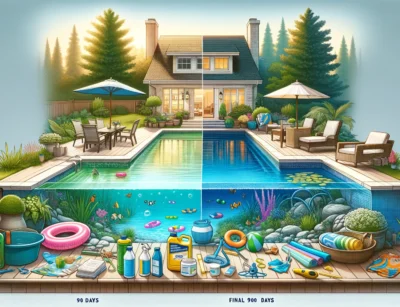
Embarking on the journey of pool ownership is an exciting venture that comes with its own set of joys, responsibilities, and learning curves. Understanding what to expect during the first 30, 60, and 90 days can help new pool owners navigate this aquatic adventure successfully.
First 30 Days: The Essentials
In the initial month, focus on the basics to ensure a smooth transition into pool ownership:
- Pool Chemicals and Testing Kits; Invest in a reliable pool testing kit to monitor water quality. Purchase essential chemicals such as chlorine, pH balancers, and algaecides to maintain a healthy pool environment.
- Basic Cleaning Tools; Acquire a skimmer, pool brush, and vacuum to keep the pool surface, walls, and floor free from debris and algae.
- Safety Measures; Prioritize safety with items like a pool cover, lifebuoy, and first aid kit. If you have children or pets, consider installing a fence to enhance pool safety.
Next 30 Days: Routine Maintenance and Comfort Upgrades
As the first month concludes, settle into a routine while considering additional comforts:
- Pool Accessories; Invest in pool accessories such as floaties, pool noodles, and inflatables for added enjoyment.
- Outdoor Furniture; Create a relaxing poolside oasis with comfortable seating, umbrellas, and loungers.
- Regular Maintenance Schedule; Establish a weekly maintenance routine, including water testing, filter cleaning, and skimming.
First 90 Days: Fine-Tuning and Optimization
By the third month, focus on optimizing pool conditions and addressing any emerging issues:
- Advanced Pool Equipment; Explore advanced equipment like robotic pool cleaners, automatic pool covers, or energy-efficient pumps to enhance efficiency.
- Landscaping and Aesthetics; Consider landscaping around the pool area for added visual appeal and privacy.
- Professional Inspection; Schedule a professional pool inspection to identify any potential issues and ensure long-term functionality.
Common Newbie Pitfalls to Watch Out For
- Neglecting Water Chemistry; Inconsistent water testing and chemical balancing can lead to algae growth and bacteria, impacting water quality.
- Overlooking Regular Maintenance; Skipping routine cleaning and maintenance tasks can result in equipment malfunctions and water clarity issues.
- Ignoring Safety Measures; Neglecting safety precautions, especially if there are children or pets around, can lead to accidents.
The first 30, 60, and 90 days of pool ownership involve gradually transitioning from the essentials to fine-tuning and optimizing your pool experience. As you embark on a rewarding and enjoyable journey as a new pool owner, remember that we’re here to answer any questions you might have. Call us to discuss the installation of your new pool or to plan for attractive landscaping that adds to your enjoyment of it.

Embarking on a home construction or renovation project is an exciting endeavor, and it’s only natural to want to express gratitude to the hardworking crew bringing your vision to life. Small gestures of appreciation can go a long way in creating a positive and collaborative atmosphere. Here are some thoughtful ways to make your construction crew feel valued and appreciated during their time working at your home.
Refreshments on Standby
Consider providing a selection of drinks and snacks to keep the construction crew energized throughout the day. Stock a cooler with bottled water, sports drinks, and a variety of snacks like granola bars, fresh fruit, or trail mix. This not only helps keep everyone hydrated and fueled but also demonstrates your consideration for their well-being.
Brunch or Lunch Treats
Surprise the crew with a delicious brunch or lunch to break up the workday. Whether it’s ordering from a local restaurant or preparing homemade sandwiches and salads, a shared meal fosters camaraderie and lets the crew know you appreciate their hard work. Take note of any dietary preferences or restrictions to ensure everyone can enjoy the gesture.
Thoughtful Comforts
Consider providing small comforts that make the work environment more pleasant. This could include setting up a shaded area with chairs or umbrellas for breaks, providing hand sanitizer or wet wipes, and ensuring there’s access to a clean and comfortable restroom. These thoughtful touches show your consideration of the crew’s working conditions.
Express Gratitude in Person
Take a moment to personally express your gratitude to the construction crew. A simple “thank you” and acknowledging their hard work can go a long way. If you have specific compliments or appreciate certain aspects of their craftsmanship, sharing those sentiments adds a personal touch to your appreciation.
Recognition and Feedback
Recognize and acknowledge the crew’s efforts throughout the project. If you notice a job well done or a particularly challenging task completed with finesse, offer positive feedback. This recognition not only boosts morale but also reinforces a sense of pride in their work.
Making your construction crew feel appreciated involves thoughtful gestures that recognize their hard work and contribute to a positive working environment. You will not only foster a collaborative atmosphere but also create a memorable and enjoyable experience for everyone involved in bringing your home project to life.
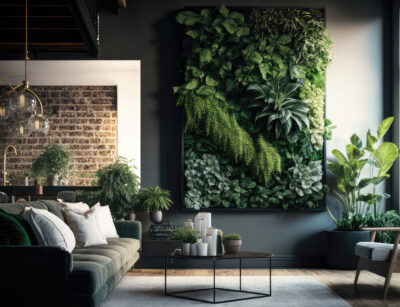
As we step into 2024, the world of outdoor design is evolving with exciting trends that promise to redefine our connection with nature. From innovative outdoor living spaces to sustainable landscapes, let’s explore the design trends anticipated to shape the outdoor world this year.
Outdoor Living Spaces. Outdoor living continues to be a focal point, with an emphasis on creating multifunctional spaces that seamlessly blend with the natural surroundings. Expansive patios, comfortable lounges, and outdoor kitchens are gaining popularity, transforming backyards into extensions of the home.
Front Yard Transformations. Front yards are no longer just passageways; they’re becoming showcases of creativity and curb appeal. Landscaping with native plants, creating welcoming entrances, and incorporating artistic elements like sculptural planters are trends breathing new life into front yard design.
Sustainable Landscapes. Sustainability takes center stage in 2024, with an increased focus on eco-friendly landscaping practices. Drought-tolerant plants, rain gardens, and permeable paving are becoming staples in outdoor designs, promoting water conservation and harmonizing with the natural environment.
Biophilic Design. The concept of biophilic design, which integrates natural elements into the built environment, is gaining momentum. From living walls to natural materials, homeowners are seeking ways to enhance their outdoor spaces with elements that foster a deep connection to nature.
Vertical Gardens. Utilizing vertical spaces for greenery is a trend expected to flourish in 2024. Vertical gardens, or “green walls,” not only maximize space but also introduce a lush, visually stunning element that enhances the overall aesthetics of outdoor areas.
Smart Garden Technology. The integration of technology into outdoor spaces is evolving with the rise of smart garden solutions. Automated irrigation systems, app-controlled outdoor lighting, and weather-sensing devices are becoming essential tools for efficient and eco-conscious garden management.
Natural Pools. As an eco-friendly alternative to traditional swimming pools, natural pools are making waves in 2024. These pools utilize plant-based filtration systems, blending seamlessly with the landscape and providing a more sustainable and visually appealing swimming experience.
Artistic Hardscapes. Hardscape elements are becoming artistic focal points with the use of creative patterns, unique materials, and sculptural installations. Patios, walkways, and outdoor structures are crafted with an emphasis on aesthetics and functionality.
These design trends signal a collective shift towards harmonizing outdoor spaces with nature, embracing sustainability, and infusing creativity into every corner of our exterior environments. From smart technology to sustainable landscapes, the outdoor world is set to transform into a haven of innovation and natural elegance this year. As you consider your options, remember that we’re here to help guide your landscape design. Call us to schedule a consultation, and we’ll help you update your outdoor space to match your needs and vision in 2024.

Gardening enthusiasts in Southern California, get ready to refresh your landscape with the latest and most captivating plant introductions for 2024. From enchanting rose varieties to vibrant flowers and charming succulents, the botanical world has some exciting additions to elevate the charm of your landscape design.
Novel Rose Varieties. Explore the world of roses with the introduction of new varieties that blend classic elegance with contemporary charm. Keep an eye out for the “Sunset Serenade,” a striking hybrid tea rose boasting hues that transition from golden yellow to fiery orange. Its exceptional fragrance and disease resistance make it a standout addition to any rose garden.
Vibrant Flower Varieties. Infuse your garden with bursts of color using the latest flower varieties tailored for Southern California’s climate. The “Sunset Glow Zinnia” is a vibrant newcomer, showcasing a mesmerizing gradient of warm hues, from coral to deep pink. These heat-tolerant flowers thrive in the sun-drenched landscapes of Southern California, providing a long-lasting display of color.
Adorable Succulents. Succulents continue to capture hearts with their charming resilience and diverse forms. The “Blushing Echeveria” steals the spotlight with its rosette of blush-pink leaves that intensify in color with sun exposure. This succulent not only adds a touch of whimsy to your garden but also requires minimal care, making it an ideal choice for Southern California’s arid conditions.
Water-Wise Perennials. Embrace sustainable gardening practices with the introduction of water-wise perennials designed to thrive in Southern California’s climate. The “Desert Marigold” is a standout, featuring golden-yellow blooms and silver-gray foliage. This drought-tolerant perennial adds a touch of the desert’s natural beauty to your garden while conserving water.
Native Plant Varieties. Celebrate the unique flora of Southern California by incorporating native plant varieties into your garden. Look for the “California Buckwheat,” a versatile and low-maintenance shrub with delicate white flowers. It attracts pollinators and adapts well to the region’s diverse microclimates.
Whether you’re cultivating a rose garden, experimenting with vibrant flowers, or embracing the allure of succulents, these new additions promise to transform your garden into a botanical haven that captivates the senses and reflects the beauty of the region. As you plan your garden for 2024, consider these new plant introductions to add a fresh burst of color, fragrance, and texture. Make sure to call us if you have any questions about incorporating new plants into your existing landscape design, and we’ll be happy to help you renovate your garden.
